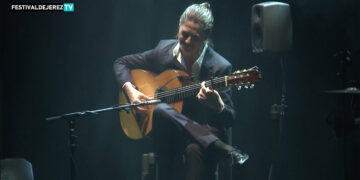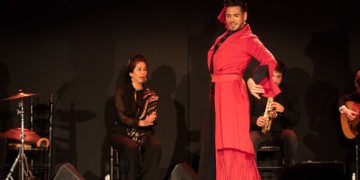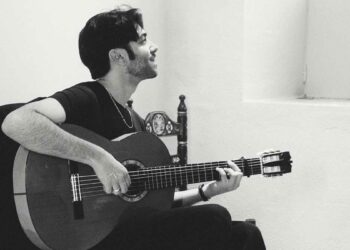|
Antonia Jiménez, Tamara Tañé |
||||||
|
Special XIII Festival de Jerez 2009 – Reviews / News / Photos Text: Estela Zatania / Photos: Ana Palma Photo gallery Antonia Jiménez, Tamara Tañé The mini festival of women guitarists, within the maxi festival of Jerez, devoted to flamenco and Spanish dance, last night turned the spotlight to Antonia Jiménez, an experienced accompanist of dance and cante for many years, debuting here as soloist. I think it’s necessary to point out that this has not been a selection of the best or most famous female flamenco guitarists. The women participating in this series are all there is, as far as professional players in flamenco. That doesn’t mean their work is any less admirable, in fact, the obstacles they’ve had to face are many and large. Antonia Jiménez, like the other three, has had to fight a little more than any male of the same level in order to be where she is today. When playing for dance, she has a powerful sure touch, but on her own, she seemed somewhat timid with her malagueño and abandolao, alegrías, farruca, “tanguillo with a guajira sound” and bulerías. In the second part, singer Tamara Tañé, with Pedro Carrasco “Niño Jero” on guitar, put the Jerez icing on the cake. Alegrías is a form ill-advised for most Jerez artists, so we’ll cut directly to the malagueña of Chacón and Mellizo, soleá por bulería with some soleá thrown in, and of course, some fine bulerías with San Miguel compás, which all added up to an enjoyable recital. Javier Barón “Dos voces para un baile” Dance: Javier Barón. Cante: Miguel Ortega, José Valencia. Guitar: Javier Patino, Ricardo Rivera. Palmas: Juan Diego, El Choro This time there was no argument. No modernists, purists or jazzists had to defend their turf. An accomplished artist faithfully interpreting a classic genre can’t set off controversy. Javier Barón, winner of Spain’s National Prize for Dance in 2008, is one of the most respected people in flamenco. “The simple approach” everyone loves to say. Of course. All you have to do is begin studying dance before the age of ten, acquire knowledge and experience through years of work, mount shows that are presented at the most prestigious festivals, and, if you are a profoundly sensitive artist, that helps too. Javier Barón gets it all together to come out on stage and give us his “simple approach”. In actual fact, great artists tend to be those who make what they do look easy. The libretto of the work is in the title: two cantaores, Miguel Ortega and José Valencia, and one dancer, Javier. What is not hinted at is the anthological run of cantes, a veritable banquet that includes, from the liviana that opens to the bulería ending, such forms as farruca, taranto, levantica, malagueña y abandolao, trilla, mirabrás, alegrías de Córdoba, siguiriya, debla, tangos de Piyayo, de Triana, soleá…. It’s easier to simply say they did everything and then some, nearly all without stopping between cantes, and at all times the common denominator is the elegance, technical perfection, aplomb and good taste of Javier Barón, without showy flourishes, just letting the compás and his own ability carry him to where he wanted to go. The lesson, for those willing to learn it, is that power is not in the person, but in how the person manages the compás and the forms. José Porcel “Cositas flamencas” Dance: José Porcel, Francisco Velasco, Leticia Calatayud, Patricia Goró. Cante: Gema Caballero, Pedro Obregón. Guitar: Paco Vidal. Violín: Raúl Márquez. Percussion: Javier Requena, Antonio Maya Dancer José Porcel brought a large group to the Sala la Compañía. Although his name isn’t quite a household word the way others are, this dancer has a long and varied background, with various works under his belt. And this shows in everything. In the staging, the wardrobe, the choreography and of course, his own dancing. There is no story line, the dances speak for themselves through music and movement. Singers Gema Caballero and Pedro Obregón have some interesting things to offer, such as the unusual variety of rhythmic fandangos that are different from what you usually hear. The tangos are noteworthy, and the show reaches its highest level with Porcel, in a white suit, dancing alegrías. This is a show that begins humbly, and grows better along the way to leave you with the satisfaction of having seen the honest work of a company that deserves more recognition. At one in the morning, we were able to enjoy the company of Paco Jerez at the peña La Zúa. Special XIII Festival de Jerez 2009 – Reviews / News / Photos |



 XIII FESTIVAL DE JEREZ 2009
XIII FESTIVAL DE JEREZ 2009 


























